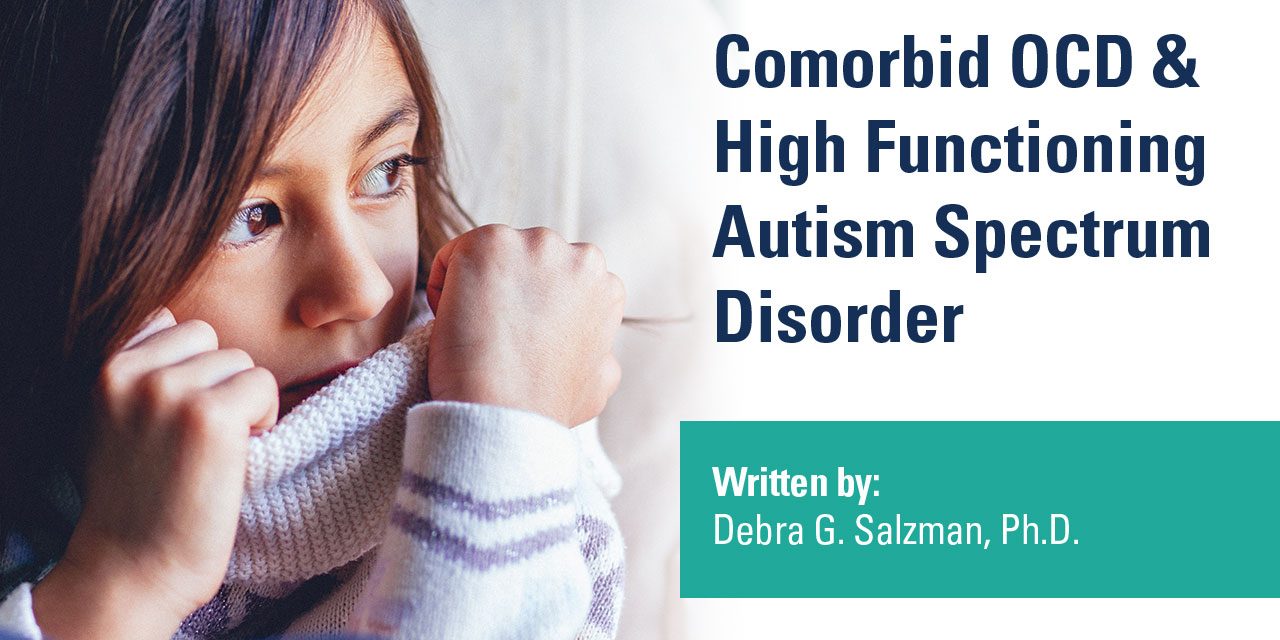The Autism-OCD Connection
Children diagnosed with Autism Spectrum Disorder (ASD) have an increased risk of experiencing a number of anxiety disorders. In particular, OCD and High Functioning Autism Spectrum Disorder have a high comorbidity (37% or higher). Obsessive Compulsive Disorder (OCD) is diagnosed by the presence of obsessions (unwanted, intrusive thoughts, images or urges) that caused significant discomfort and/or compulsions (behaviors) that the person feels driven to do to decrease their discomfort and/or get rid of the obsession.
In order to meet the criteria for OCD, the obsessions and/or compulsions need to be time consuming or cause marked interference in the person’s life. Common obsessions include thoughts of contamination or getting sick, fear of causing harm, fear of losing control, fear of making the wrong decision, doubting whether the person did something (brought my books home, turned out the light), and worry over things being in the right place. Common compulsions include handwashing, checking, seeking reassurance from parents and teachers, re-reading, erasing and re-writing, doing things a certain number of times, saving everything, excessive showering and arranging things.
Impact of OCD on the Child and Family
These behaviors can lead to significant interference in a child’s and family’s life. At times, parents become prisoners to their child’s OCD symptoms, doing everything they can to help their child avoid being anxious and avoid a tantrum or meltdown. Parents and caregivers are often struggling to manage other challenging behaviors, so the addition of comorbid OCD creates ever-increasing challenges. Parents, caregivers and teachers do what comes naturally, which is to provide reassurance and structure the child’s day to avoid the OCD triggers. Unfortunately, reassurance and avoidance only serve to maintain the OCD and leads to increasing symptoms over time.
Breaking the Cycle of OCD
Treatment aimed at reducing OCD symptoms requires just the opposite, facing your feared scenarios and preventing oneself from ritualizing, breaking the connection between the obsession and compulsion. This treatment is called Exposure and Response Prevention (ERP). This is done step by step by creating a hierarchy of feared scenarios and difficult situations explaining what needs to be done (by both the parent and child) at each step. Of course, this requires motivation on the part of the child.
Therefore, ERP will have the best success among those with high functioning autism. A child with higher cognitive skills will have more understanding of the essential features needed for ERP. The child is agreeing to begin a treatment that, in the short-term, will increase his/her anxiety knowing that eventually, the anxiety (and OCD) will decrease. Investing anxiety in the short-term for a life free of ritualizing and no longer being a prisoner to the OCD is a hard task even for children and adults without an ASD diagnosis to agree to. The challenge becomes helping the child with a comorbid ASD diagnosis understand the benefits of treatment and increasing their motivation to “fight the OCD monster.”
Challenges to Treatment
There are many challenges to treatment for children with a comorbid ASD and OCD diagnosis. Motivation is probably one of the hardest to address. Time spent outlining the ways in which OCD interferes in the child’s life and the feelings of helplessness to fight “the bully” of OCD can help to improve motivation. Parents and caregivers may need to stop “giving in” to the OCD as well in order for the child to feel motivated to work on the issue. Parents who change their own clothes when they walk into the house to help a child with contamination fears are not providing an environment for the child to see the need for change.
Knowing that there may be reduced motivation, treatment for individuals with a co-occurring diagnosis may need to move at a slower pace. Time spent on making sure the child fully understands the reasons why we are “facing the monster” helps to improve motivation Providing smaller steps for change, allowing the child to have more control in the pace of the treatment may also increase motivation.
Exposure and Response Prevention for individuals with a comorbid diagnosis with high functioning autism presents unique challenges but ones that can be overcome. Treatment is highly effective and can create meaningful change in the child’s and family’s life. Understanding OCD and the mechanisms that maintain the OCD are the first steps towards change. anti depression lexapro
References
Foa, E.B. and Wilson, R. (2001). Stop Obsessing! New York: Bantam Books.
Gillihan, S.J., Williams, M. ., Malcoun, E., Yadin, E., & Foa, E.B. (2012). Common pitfalls in exposure and response prevention (EX/RP) for OCD. Journal of Obsessive-Compulsive and Related Disorders, 1, 251-257.
Lewin, A.B., Wood, J.J., Gunderson, S., Murphy, T.K., & Storch, E.A. (2011). Phenomenology of comorbid autism spectrum and obsessive-compulsive disorders among children. Journal of Developmental and Physical Disabilities, 23(6), 543-553.
Meier, S.M., Petersen L., Schendel D.E., Mattheisen, M., Mortensen, P.B., Mors, O. (2015). Obsessive-compulsive disorder and autism spectrum disorders: Longitudinal and offspring risk. PLoS ONE 10(11): e0141703. https://doi.org/10.1371/journal.pone.0141703
Russell, A., Mataix-Cols, D., Anson, M., & Murphy, D. (2005). Obsessions and compulsions in Asperger syndrome and high functioning autism. British Journal of Psychiatry, 186(6), 525-528.
About The Authors:
Debra G. Salzman, Ph.D. is a Clinical Psychologist and is licensed in New Jersey. Dr. Salzman received her Ph.D. in clinical psychology from the State University of New York at Albany. She completed her doctoral internship at the Medical College of Pennsylvania—Eastern Pennsylvania Psychiatric Institute.
Dr. Salzman has extensive experience in the assessment and treatment of children, adolescents and adults. She has a special interest in anxiety disorders, social skills deficits, past and present childhood sexual abuse, disruptive behavior disorders, depression, coping with trauma, Obsessive Compulsive Disorder, selective mutism, social phobia and training parents on behavior management strategies to improve child behavior.
She will present a workshop on Obsessive Compulsive Disorder and High Functioning Autism at Autism New Jersey’s Annual Conference in October 2018.







